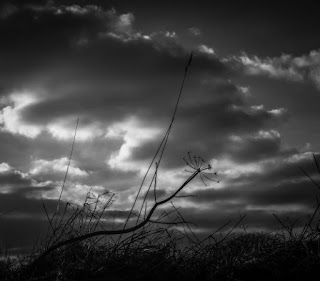As I grew into the habit of carrying a camera everywhere (well, perhaps not the supermarket), the first thing I concentrated on was getting to grips with composition. Keep in mind the rule of thirds but always remember, rules are made to be broken. Trust your eye and your gut sometimes and just shoot. Also, it may sound obvious, but don't fall into the trap of thinking that a particular scene will be magically transformed within your camera. If it looks unremarkable to the naked eye, then the chances are it will make for a dull photograph.
 |
This image on the left, for example, doesn't really adhere to the rule of thirds, but I think...I hope it works.
Very soon after incorporating photography into my daily life, my restless streak kicked in and I became increasingly dissatisfied with the images coming straight out of the camera. This had nothing to do with exposure, composition or image quality (I was at this point using Auto settings), but I felt they were a little lacklustre. I wanted depth of field, to play with the light, but more than anything, I wanted drama!
If drama is not already present, then I make some effort to create it, although, as I have said before, light plays a major part in this. A flat white sky has very little to offer. Overcast, cloudy conditions are great, as is morning light, twilight and sunlight casting long shadows.
I think I must be a frustrated stills photographer (in my dreams!), because with pretty much every image, I see - before clicking the shutter button - how I want the finished image to look, or something about the subject speaks to me in some way. Usually, in my head, there will be a cinematic or literary point of reference. Achieving that look however, is another matter and something I strive for every time. Here are 10 examples of where my mind's eye takes me:-
 |
| 1. Tall Trees - Stephen King, creepy, Scandi dramas |
 |
| 3. Rural Villages: Agatha Christie, any given period drama, Withnail & I. |
 |
| 4. Maize fields - The Bad Seed, Spielberg. |
 |
| 5. Pampas Grass, White Picket Fence - David Lynch. |
 |
6. Ponds - Quite specific this, but the disturbed woman who drowned in Cider with Rosie. Mercifully, I don't insist on a model! |
- Rural landscapes, rolling hills and valleys - Middle Earth.
- Churches, Abbeys, large period houses - Omen, Black Narcissus.
10. Street scenes - I tend to favour black and white in urban settings, so look for shadows, reflections and clean lines; all very film noir. Maybe I'll spot Hitchcock's image reflected in a shop window? It doesn't matter that he shuffled off this mortal coil over 40 years ago!
So you see? There's a darkness running through my images. Even when photographing the recent snowfall, I was thinking of The Shining or the Coen Brothers' Fargo. What that says about me is probably best left to a psychologist. All I know is, the more punch I can get out of an image, the better.
Some amateurs like to say that photos shouldn't be edited, but I think you will find that most photographers agree that any given image you see online or in a magazine has been edited to a degree. These adjustments can be subtle - for example adding a little contrast, or increasing the luminance or saturation of certain colours - or big and bold by adding overlays, airbrushing, or introducing/removing objects from a photograph.
 |
| I photoshopped this balloon from one of my photos into the more desirable setting of another of my images. |
Executed well, these edits are what elevate a snapshot to art (I'm still trying to get to that point and am inspired by other photographers on Instagram on a daily basis!)
TOGGER'S TIP FOR MOODY LANDSCAPES: Bring down the exposure and highlights, lift the shadows, increase white a little, play with contrast and clarify. Re-adjust exposure and highlights to suit.
That said, in the early days, I think I went slightly overboard. I was (well still am) obsessed with dramatic clouds, but now, looking at my early images, all I can see are the halos of over processing. Sometimes less is more. Always have an eye on the detail. Zoom in on an image and double check your edits aren't too obvious.
 |
| Avert your gaze! Too much!! |
Finally, to touch briefly on software, for a long time I used a really old version of Paint Shop Pro. Now I pay a monthly subscription to use Lightroom and Photoshop. However, the free mobile Photoshop App is also extremely useful for editing mobile shots and jpegs. We recently had to upgrade our pc and for a time I was reliant on our ye olde laptop, minus any editing software. I took to emailing myself the jpegs (not RAW images, as I didn't want to overload the laptop - so breaking another rule here). I would then edit them on my phone. It worked pretty well in the absence of a suite of editing software. Can you tell this is a jpeg and not a RAW image?
Drama, smoke and mirrors cover a multitude of sins.






































